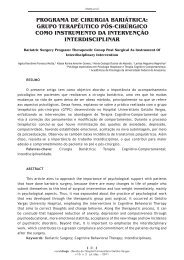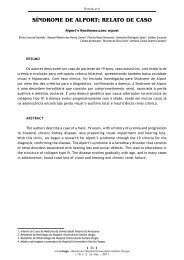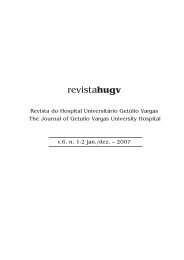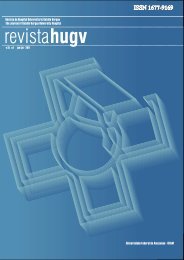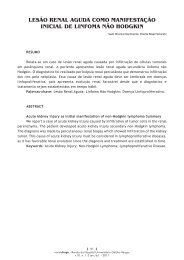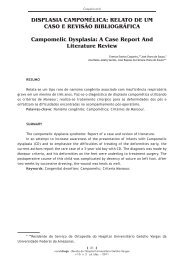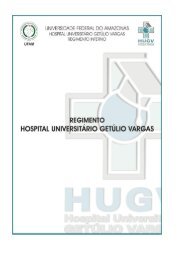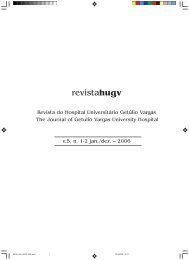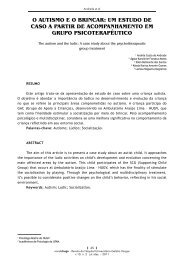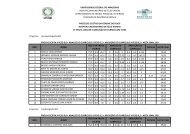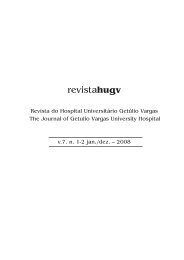Revista HUGV 2006 - Hospital Universitário Getúlio Vargas - Ufam
Revista HUGV 2006 - Hospital Universitário Getúlio Vargas - Ufam
Revista HUGV 2006 - Hospital Universitário Getúlio Vargas - Ufam
Create successful ePaper yourself
Turn your PDF publications into a flip-book with our unique Google optimized e-Paper software.
RESUMOIMUNIZAÇÃÇÃO ERITROCITOCITÁRIA EM PACIENTES COM DOENÇAFALALCIFCIFORME NO ESTADO DO AMAZONASASERITROCITY IMMUNIZATION IN PATIENTS WITH SICKLE DISEASE IN THE STATE OF AMAZONMIHARU M. MATSUURA, JOSÉ ORLANDO BORDINRESUMO: O propósito deste estudo foi analisar o perfil imunohematológico dos pacientes com doença falciformedo Estado do Amazonas por meio da detecção e identificação de alo e auto-anticorpos antieritrocitários, bem comocaracterizar os principais sistemas de grupo sangüíneo desses pacientes e investigar a freqüência de aloimunizaçãoeritrocitária causada pelas diferenças fenotípicas entre os pacientes com doença falciforme e doadores de sangue doHemocentro do Amazonas – Hemoam. A taxa de aloimunização eritrocitária encontrada, neste estudo, foi de 18,0%,64,3% dos aloanticorpos antieritrocitários detectados nos pacientes com doença falciforme do Hemoam foram dosistema Rh e Kell. A taxa de auto-imunização eritrocitária encontrada, neste estudo, foi de 8,3%, sendo todos osauto-anticorpos do tipo quente (IgG) e um paciente tinha fração de complemento C3d, além do auto-anti IgG. Aanálise estatística mostrou que a taxa de imunização não foi influenciada pelo sexo, faixa etária, número de gestaçãoou número de transfusão, mas foi observada diferença estatisticamente significante na relação dos auto-anticorposeritrocitários com aloimunização e reação transfusional. Acredita-se que a presença prévia de aloanticorpospode predispor a formação de auto-anticorpos eritrocitários e esses auto-anticorpos podem freqüentemente estarassociados com a ocorrência de reação transfusional nos pacientes falcêmicos. Verificou-se que as diferenças encontradasna fenotipagem eritrocitária entre os doadores e receptores deste estudo não influenciaram a aloimunizaçãoeritrocitária, permitindo supor que os doadores de sangue e pacientes com doença falciforme no Amazonas sãosemelhantes nos principais fenótipos de sistema de grupos sangüíneos. Em conclusão, este estudo permitiu contribuirpara um melhor conhecimento da imunização eritrocitária, nos pacientes com doença falciforme, podendoprevenir o aparecimento de reações transfusionais e promover uma maior segurança e eficácia transfusional.Palavras-chave: Doença falciforme; Aloimunização; Antígenos eritrocitários; Transfusão sangüínea; Auto-imunização.ABSTRACT: The intention of this study was to analyze the immunohematologic profile of the patients with sicklecell disease of the State of Amazon by detecting and identifying irregular allo and selfantibodies against red bloodcells antigens, as well as characterize the main sanguineous group systems of these patients, and investigate thefrequency of eritrocity aloimmunization, caused by phenotypic differences between Amazon Blood Center -HEMOAM’s blood donors and the patients with sickle cell disease. The found rate of red cell antigensalloimmunization in this study, was of 18,0%, 64,3% of the detected alloantibodies against red blood cell in thepatients with sickle cell disease of the HEMOAM had been of the system Rh and Kell. The found rate of eritrocityselfimmunization in this study was of 8,3%, with all the selfantibodies being of the hot type (IgG) and a patient hadcomplement fraction of C3d, as well as the auto-anti IgG. The statistical analysis showed that the immunization ratewas not influenced by the sex, age, number of gestations or number of transfusions but observed a statisticalsignificant difference in the relation of the eritrocity selfimmunization with alloimmunization and transfusionalreaction. It is believed that the previous presence of alloantibodies can predispose the eritrocity selfantibodiesformation and these antibodies can frequently be associated with transfusional reaction in the sickle patients. Itwas observed that the found differences in the phenotypied red blood cells between blood donors and bloodreceivers of this study had not influenced the red cell antigens alloimmunization, allowing one to assume that theblood donors and patients with sickle cell disease in the Amazon are similar in the main phenotipies of sanguineousgroups systems. In conclusion, this study allowed contributing for better knowledge of the immunization againstthe red blood cells in patients with sickle cell disease, being useful to prevent the appearance of transfusionalreactions and to promote a greater security and transfusional effectiveness.Key-words: Sickle cell disease; Alloimmunization; Red blood cell antigens; Blood transfusion; Selfimmunization.Correspondência para:Miharu Maguinoria Matsuura MatosRua 23 n.º 935 Conj. Castelo Branco – Parque 1069055-410 – Manaus – Amazonas – BrasilE-mail: miharumatos@gmail.comDissertação apresentada à Universidade Federal de São Paulo – Escola Paulista de Medicina para obtenção doTítulo de Mestre em Ciências Hematológicas. Área de concentração: Hematologia e Hemoterapia.revistahugvhugv – <strong>Revista</strong> do <strong>Hospital</strong> Universitário Getúlio <strong>Vargas</strong>v. 5. n. 1-2 jan./dez. – <strong>2006</strong>81




